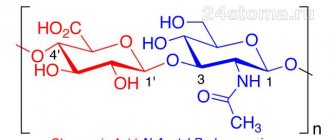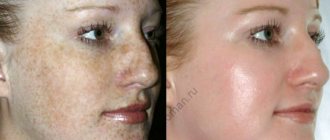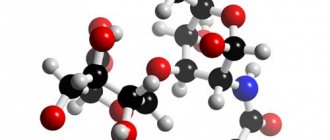December 14, 2021
- What is hyaluronic acid
- What is hyaluronic acid made from?
- Beneficial features
- Types of hyaluronic acid Low molecular weight
- High molecular weight
- Cleansing and toning
Hyaluronic acid is known as a miracle ingredient, a beauty elixir that can restore youth to the skin and is therefore very often used in cosmetics. We'll tell you what this substance is, what its benefits are and whether it can be harmful.
What is hyaluronic acid
Hyaluronic acid, or hyaluronate, is found in any body and is a “building material”. It is found in connective tissues and skin and is responsible for retaining moisture. One hyaluronate molecule is capable of holding a volume of water that is a thousand times greater than its own volume.
As you age, your body produces less and less of this substance. This is due to:
- natural cell aging;
- exposure to UV radiation;
- bad environment;
- unhealthy lifestyle and some other factors.
Due to a lack of hyaluronate, the epidermis begins to suffer from dryness, and as a result, visible signs of aging appear and develop. Fortunately, the lack of this substance can be replenished externally. Back in the 30s of the 20th century, they learned to isolate the component and later synthesize it.
How a lack of hyaluronic acid leads to skin aging -
Almost all of the skin's hyaluronic acid is located in its dermal layer (Fig. 2) - exactly where the collagen and elastin fibers responsible for skin elasticity are located. Loss of moisture (dehydration) from this layer of skin leads to the following effects:
- Slow collagen degeneration - a decrease in the amount of hyaluronic acid leads to a decrease in water content in the dermis, which leads to weak hydration of collagen and elastin fibers with water. Under these conditions, slow degeneration of collagen fibers occurs with a gradual decrease in its quantity. In addition, all other collagen loses the proper degree of plasticity (ability to shrink/decompress). And this affects the elasticity of the skin.
- Reduced skin thickness – dehydration of the dermal layer of the skin leads to a decrease in its thickness, accordingly, the skin becomes thinner and less elastic. Thin skin is more prone to the early appearance of wrinkles.
- Reduced activity of fibroblasts and keratinocytes - fibroblasts are responsible for the synthesis of collagen and elastin. When there is a lack of hyaluronic acid, their activity decreases, which affects their collagen production. The activity of keratinocytes, on which the thickness of the epidermal layer of the skin depends, also decreases. A decrease in the thickness of the epidermis leads to a decrease in the protective properties of the skin and to greater evaporation of water from its surface.
Hyaluronic acid for the face: reviews from cosmetologists... thus, the additional supply of hyaluronic acid (with a decrease in its content in the dermis) helps ensure that the dermis is saturated with moisture and the collagen remains sufficiently hydrated with water. Plus, the activity of fibroblasts and keratinocytes increases, stimulates angiogenesis, cell regeneration, and metabolic processes. All this keeps the skin well hydrated, elastic and, accordingly, prevents the development of wrinkles.
What is hyaluronic acid made from?
Hyaluronate can be obtained in two ways:
- isolated from animal raw materials;
- synthesize artificially.
Previously, the substance was isolated from fish, cattle cartilage, and rooster combs, but now a biotechnological method is common, in which lactic acid bacteria are used for fermentation. The substance is purified and dried to a powder state. It is in this form that it is able to penetrate deeply into the layers of the epidermis.
In addition to cosmetics, hyaluronate is widely used in orthopedics, ophthalmology (including for the manufacture of contact lenses) and eye surgery. The substance may also be included in food supplements.
Properties of high molecular weight hyaluronic acid
High molecular weight hyaluronic acid penetrates deeper into the skin to a lesser extent. It performs a completely different function, namely actively moisturizes the surface. Its use in cosmetology in a number of procedures provides an immediate tightening effect - skin smoothing. Another property is the stimulation of cellular processes in the skin.
This substance makes the skin surface:
- Elastic;
- Highly resistant to negative external influences.
This type of hyaluronic acid is used in:
- Surgery;
- Ophthalmology;
- Cosmetology.
High molecular weight varieties of this substance with a molecular weight of 500 – 730 kDa help:
- Restrain the increase in the number of blood and lymphatic vessels;
- Stop inflammatory processes;
- Restrain the division and movement of cells into the damaged area;
- Strengthen the connection of enzymes and cell restoration;
- Prevent cartilage destruction.
High molecular weight hyaluronic acid has the following properties:
- Anti-inflammatory;
- Antioxidant;
- Restorative.
Its presence in preparations helps to increase the effect on the body of other beneficial ingredients contained in it.
Types of hyaluronic acid
There are two types of hyaluronate used in cosmetics: low molecular weight and high molecular weight. Let's tell you a little more about each of the varieties.
Low molecular weight
This substance is able to quickly penetrate into the deep layers of the epidermis, due to which it is used in cosmetics. It is included in creams, serums, anti-acne products and other cosmetic products.
High molecular weight
This type of hyaluronate is used in cosmetology, as it slowly breaks down in tissues. This quality allows you to achieve a long-term effect after the procedure. The substance can also be used in cosmetics, but it does not penetrate deep and does not form intercellular connections. When applied to the skin, high molecular weight hyaluronic acid serves to provide superficial hydration.
Why does the content of hyaluronic acid in the skin decrease?
The fun begins with this question.
Cosmetologists and cosmetics manufacturers impose on consumers the idea that with age, the amount of hyaluronic acid in the skin decreases critically. Allegedly, up to a certain point there is enough of it, and then it begins to be sorely lacking. The “point of no return” is called differently: 18, 20, 25, 30 years. The promotion of all cosmetics and injections based on hyaluronic acid is based on this myth.
In fact, everything is different. The amount of hyaluronic acid in the body remains almost unchanged. The human body consists of 0.007% hyaluronate. For a woman weighing 60 kg, this is approximately 13 grams.
Hyaluronic acid is a regularly renewed, but not disappearing component. About 5 grams of hyaluronic acid are broken down and synthesized per day.
So its molecules are ready to work in full force even after 30, 40, 50, etc. years.
The problem comes from the other side, from within. The required amount of moisture simply does not reach the hyaluronic acid; the capillaries do not carry it. There's nothing to hold on to.
The fact of the matter is that our skin NEEDS its own hyaluronate to remain young and elastic. No need to add new hyaluronic acid.
What then is needed? Add moisture, raise all the “barriers” on its way to the cells.
To do this, we restore skin microcirculation, free blood vessels from the “shackles” of spasmodic muscles, and improve trophism (nutrition) of cells. This is what the participants of the “Flourish” marathon from MelAnnett do. Join us!
How does hyaluronic acid work on the skin?
When the skin lacks moisture, it doesn't just feel dry. Over time, the skin becomes less firm and elastic, loses its radiance, and as a result, wrinkles may appear.
The use of low molecular weight hyaluronic acid replenishes the need for hydration of the epidermis, filling the intercellular space, which, in turn, has the following effects:
- the lipid layer is restored;
- elasticity and firmness of the skin returns, visible signs of age-related changes decrease or disappear;
- the skin becomes softer and more pleasant to the touch, the relief is evened out;
- complexion improves.
Low molecular weight, high molecular weight... What is it?
Everyone is used to affectionately calling it “hyaluronic acid,” but in fact, hyaluronic acid comes in different forms (“black, white, red...”







